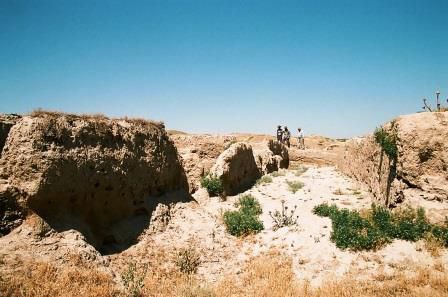
The ancient city of Panjakent is located 1.5 km southwest of the city of Panjakent.
Ancient Panjakent has all the pillars of the city. Now from under the ground, walls of residential, administrative and religious buildings occasionally appear. Panjakent is one of the eastern cities of Sogd, subordinate to the city of Samarkand. During the reign of Devashtich, this royal center develops to such an extent that it does not submit to the center of Sogd, the city of Samarkand, but claims to subjugate Samarkand. The Sogdian people lived in the city of Panjakent and communicated in the Sogdian language. Archaeological excavations have been carried out only in half of the city and are still ongoing. As a result, a governor’s castle, two temples with courtyards in the city center, a main street and ten narrow streets, alleys and craft shops, bazaars, and defensive walls of the castle were discovered. It is obvious that the city was inhabited mainly by nobles. But besides them, there were also rowing boats. The residential buildings consisted of two and three floors. It is not unlikely that merchants also lived in this city and conducted trade by caravans from China to Rome along the Silk Road. Thick and strong walls, narrow streets between buildings allowed people to build two-story warehouses here, where they stored their grain. Each city had a reception hall, decorated with oriental colors, carvings, and its walls were painted. Each of them tried to decorate its hotel like a royal palace, which is a sign of the high culture of the local residents. Now most of these finds are kept in the large museums of Panjakent itself, Dushanbe, and the Hermitage in St. Petersburg.
The people of Panjakent practiced Zoroastrianism. Two large temples in the center of the city testify to their faith. A god is carved on a wooden trunk, sitting on a throne. Like other civilized peoples, one of the main occupations of the Panjakents is gardening and livestock. However, it is strange that there were no trees or livestock inside the city, except for two sacred trees. The garden was developed outside the city. The people’s livestock was also raised outside the city. The remains of the pipe indicate that the city had a single sewage system. Although the city is located on a hill, water is brought to the city center through an underground pipe and is pumped up from special wells located in several places in the city. This is due to the fact that the governor’s castle and control offices are located outside the city. Devashtich entered the city through a special road. From the finds of various gods, it is clear that the market was convenient in the city and people traded from all corners of the world. And conditions have been created for them so that everyone can worship their own religion.
The peaceful life of the people of ancient Panjakent was put to an end by Ibn Qutayba, an Arab general. After conquering Samarkand, he sent an army to Panjakent. Devashtich, considering resistance futile, prayed for his people and handed over Panjakent to the Arabs. Now some scholars believe that Devashtich converted to Islam at the end of his life.
The Sogdians were aware of the achievements of the civilization of the great peoples of their time. In this regard, in their culture, one can encounter elements of the culture of other peoples, including Rome and India. However, the art and culture of the Sogdians differ from the culture of other peoples with their uniqueness of style, unique style, and distinctive elements.
The discovery of ancient Panjakent is a unique achievement for the history of Tajikistan, as the monuments and sites reflect the literature, folklore, and customs of the past of the Tajik people, and are another reason for pride and honor!